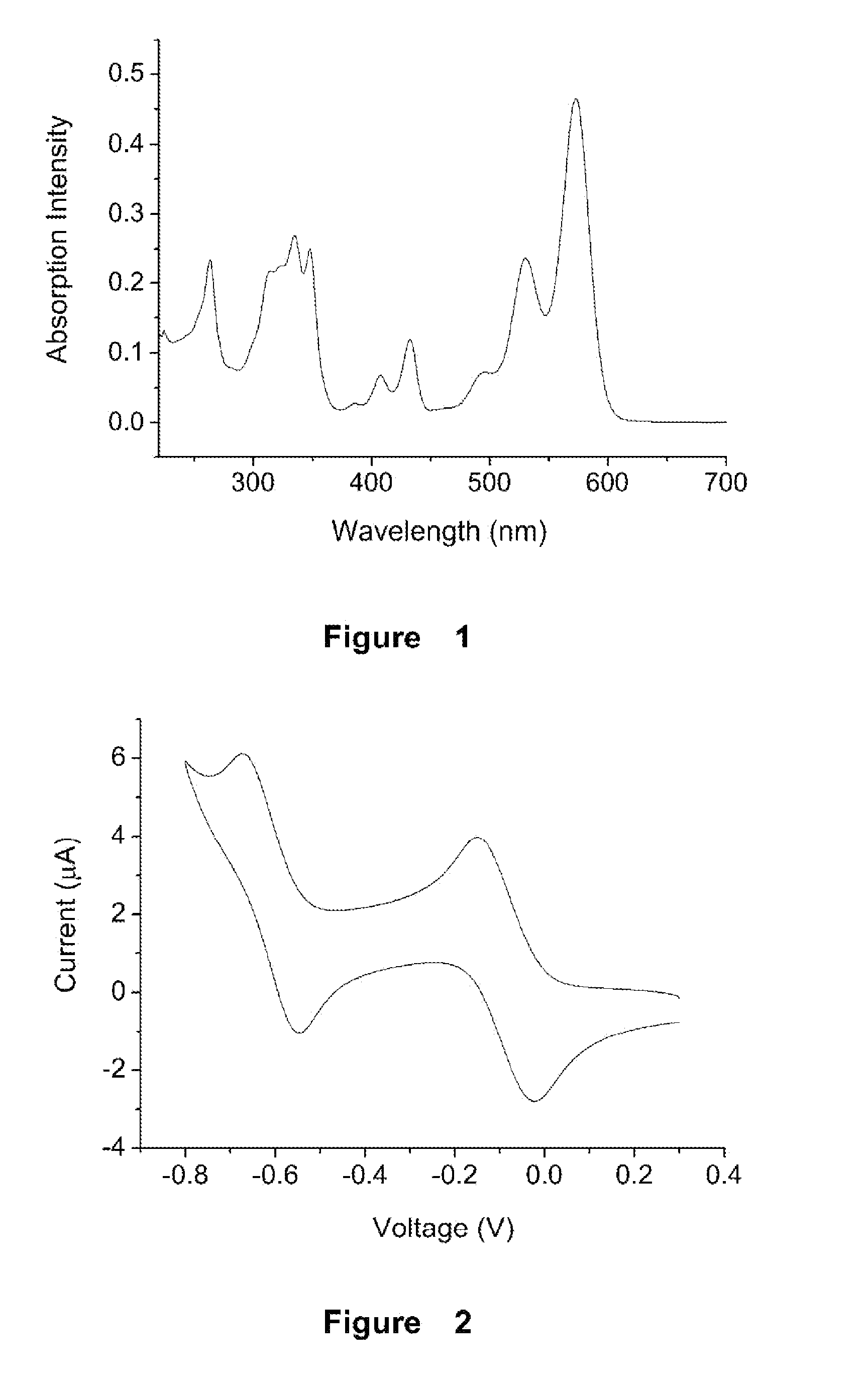Sulfur Containing Heterocycle-Fused Naphthalene Tetracarboxylic Acid Diimide Derivatives, Preparation Method And Use Thereof
a technology of naphthalene tetracarboxylic acid and heterocycle, which is applied in the field of sulfur containing heterocyclefused naphthalene tetracarboxylic acid diimide derivatives, can solve the problems of poor film-forming ability, poor device performance, and low electron mobility of otft devices, and achieves low cost, easy and efficient production, and easy and efficient production
- Summary
- Abstract
- Description
- Claims
- Application Information
AI Technical Summary
Benefits of technology
Problems solved by technology
Method used
Image
Examples
examples 1-8 (
Chemical Structures are Illustrated Below)
[0089]
example 1
Synthesis of N,N′-di(2-decyltetradecyl)-[2,3-d:6,7-d′]-bi[2-(1,3-dithiacyclopenten-2-ylidene)-2-malononitrile]-naphthalene-1,4,5,8-tetracarboxylic acid diimide (1)
[0090]N,N′-di(2-decyltetradecyl)-2,3,6,7-tetrabromonaphthalene-1,4,5,8-tetracarboxylic acid diimide (22) (126 mg, 0.1 mmol), 2,2-dicyanoethylene-1,1-dithiol disodium (56 mg, 0.3 mmol), and tetrahydrofuran (20 mL) were added into a 100 ml three-neck flask, reacted at 50° C. for 1 hour, then the solvent was removed by a rotary evaporator under reduced pressure. The crude product was purified by silica gel chromatography column using dichloromethane / petroleum ether (3 / 1) as an eluent to give 60 mg of a purple black solid (compound 1), and the yield was 50%. Mp: 240° C. (from DSC);
[0091]MS (MALDI-TOF) m / z 1215.8 (M+);
[0092]1H-NMR (300 MHz, CDCl3) δ (ppm): 0.849-0.889 (m, 6H, —CH3), 1.231 (b, 40H, CH2), 1.988-2.014 (m, 1H, CH), 4.219-4.244 (d, J=7.50 Hz, 2H, —CH2—N);
[0093]13C-NMR (100 MHz, CDCl3): δ 14.11, 22.68, 26.28, 29.34, ...
example 2
Synthesis of N,N′-di(2-octyldodecyl)-[2,3-d:6,7-d′]-bi[2-(1,3-dithiacyclopenten-2-ylidene)-2-malononitrile]-naphthalene-1,4,5,8-tetracarboxylic acid diimide (2)
[0095]The same synthetic method for compound 1 was used except using 23 instead of 22, and the yield was 53%. Mp: 265° C. (from DSC);
[0096]MS (MALDI-TOF) m / z 1105.4 (M+);
[0097]1H-NMR (300 MHz, CDCl3) δ (ppm): 0.840-0.891 (m, 6H, —CH3), 1.236 (b, 32H, CH2), 2.002-2.022 (m, 1H, CH), 4.222-4.246 (d, J=7.20 Hz, 2H, —CH2—N);
[0098]13C-NMR (100 MHz, CDCl3): δ 14.13, 22.67, 22.69, 26.28, 29.30, 29.35, 29.52, 29.57, 29.65, 30.02, 31.49, 31.87, 31.93, 36.59, 46.48, 71.22 (═C(CN)2), 111.60, 111.74 (CN), 125.10, 145.35, 161.97 (C═O), 181.95 (═CS2);
[0099]Elemental analysis: calcd. for: C62H82N6O4S4: C, 67.48; H, 7.49; N, 7.62. found: C, 67.38; H, 7.58; N, 7.56.
PUM
| Property | Measurement | Unit |
|---|---|---|
| molar ratio | aaaaa | aaaaa |
| threshold voltage | aaaaa | aaaaa |
| LUMO energy level | aaaaa | aaaaa |
Abstract
Description
Claims
Application Information
 Login to View More
Login to View More - R&D
- Intellectual Property
- Life Sciences
- Materials
- Tech Scout
- Unparalleled Data Quality
- Higher Quality Content
- 60% Fewer Hallucinations
Browse by: Latest US Patents, China's latest patents, Technical Efficacy Thesaurus, Application Domain, Technology Topic, Popular Technical Reports.
© 2025 PatSnap. All rights reserved.Legal|Privacy policy|Modern Slavery Act Transparency Statement|Sitemap|About US| Contact US: help@patsnap.com



